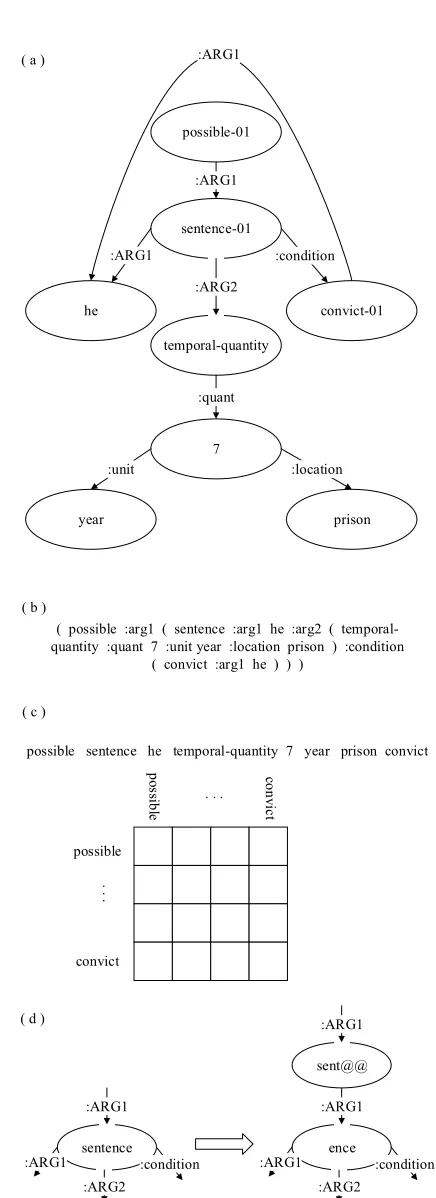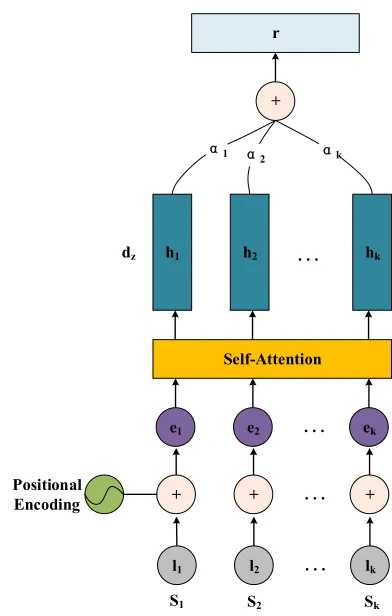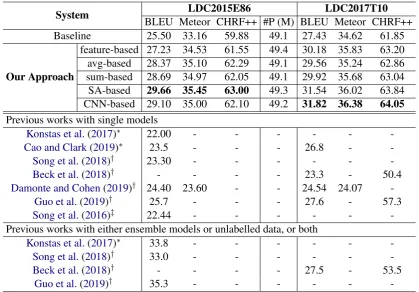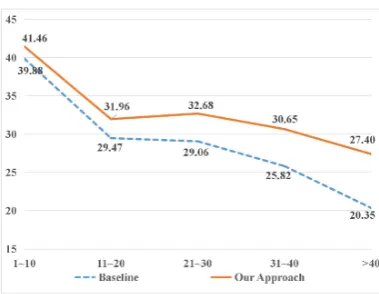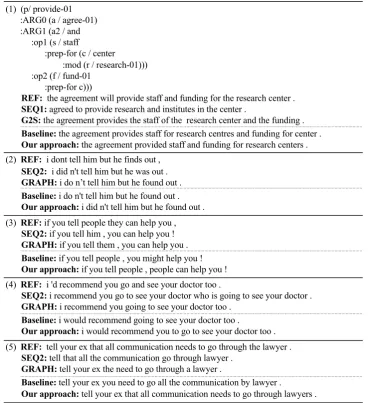Proceedings of the 2019 Conference on Empirical Methods in Natural Language Processing 5459
Modeling Graph Structure in Transformer
for Better AMR-to-Text Generation
Jie Zhu1 Junhui Li1∗ Muhua Zhu2 Longhua Qian1 Min Zhang1 Guodong Zhou1
1School of Computer Science and Technology, Soochow University, Suzhou, China 2Alibaba Group, Hangzhou, China
zhujie951121@gmail.com,{lijunhui, qianlonghua, minzhang, gdzhou}@suda.edu.cn muhua.zmh@alibaba-inc.com
Abstract
Recent studies on AMR-to-text generation often formalize the task as a sequence-to-sequence (seq2seq) learning problem by con-verting an Abstract Meaning Representation (AMR) graph into a word sequence. Graph structures are further modeled into the seq2seq framework in order to utilize the structural in-formation in the AMR graphs. However, pre-vious approaches only consider the relations between directly connected concepts while ig-noring the rich structure in AMR graphs. In this paper we eliminate such a strong limita-tion and propose a novel structure-aware self-attention approach to better modeling the re-lations between indirectly connected concepts in the state-of-the-art seq2seq model, i.e., the Transformer. In particular, a few different methods are explored to learn structural rep-resentations between two concepts. Experi-mental results on English AMR benchmark datasets show that our approach significantly outperforms the state of the art with 29.66 and 31.82 BLEU scores on LDC2015E86 and LDC2017T10, respectively. To the best of our knowledge, these are the best results achieved so far by supervised models on the bench-marks.
1 Introduction
AMR-to-text generation is a task of automatically generating a natural language sentence from an Abstract Meaning Representation (AMR) graph. Due to the importance of AMR as a widely adopted semantic formalism in representing the meaning of a sentence (Banarescu et al., 2013), AMR has become popular in semantic representa-tion and AMR-to-text generarepresenta-tion has been draw-ing more and more attention in the last decade. As the example in Figure1(a) shows, nodes, such asheandconvict-01, represent semantic concepts
∗
Corresponding Author: Junhui Li.
and edges, such as “:ARG1” and “:quant”, re-fer to semantic relations between the concepts. Since two concepts close in an AMR graph may map into two segments that are distant in the cor-responding sentence, AMR-to-text generation is challenging. For example in Figure 1, the neigh-boring conceptshe andconvict-01 correspond to the wordsheandconvictedwhich locate at the dif-ferent ends of the sentence.
To address the above mentioned challenge, re-cent studies on AMR-to-text generation regard the task as a sequence-to-sequence (seq2seq) learning problem by properly linearizing an AMR graph into a sequence (Konstas et al., 2017). Such an input representation, however, is apt to lose useful structural information due to the removal of reen-trant structures for linearization. To better model graph structures, previous studies propose various graph-based seq2seq models to incorporate graphs as an additional input representation (Song et al., 2018; Beck et al., 2018; Damonte and Cohen, 2019). Although such graph-to-sequence models can achieve the state-of-the-art results, they focus on modeling one-hop relations only. That is, they only model concept pairs connected directly by an edge (Song et al.,2018;Beck et al.,2018), and as a result, ignore explicit structural information of in-directly connected concepts in AMR graphs, e.g. the relation between concepts he andpossible in Figure1.
Empirical studies on two English benchmarks show that our approach significantly advances the state of the art for AMR-to-text generation, with the performance improvement of 4.16 BLEU score on LDC2015E86 and 4.39 BLEU score on LDC2017T10 respectively over the strong base-line. Overall, this paper makes the following con-tributions.
• To the best of our knowledge, this is the first work that applies the Transformer to the task of AMR-to-text generation. On the basis of the Transformer, we build a strong baseline that reaches the state of the art.
• We propose a new self-attention mechanism to incorporate richer structural information in AMR graphs. Experimental results on two benchmarks demonstrate the effectiveness of the proposed approach.
• Benefiting from the strong baseline and the structure-aware self-attention mecha-nism, we greatly advance the state of the art in the task.
2 AMR-to-Text Generation with Graph Structure Modeling
We start by describing the implementation of our baseline system, a state-of-the-art seq2seq model which is originally used for neural machine trans-lation and syntactic parsing (Vaswani et al.,2017). Then we detail the proposed approach to incorpo-rating structural information from AMR graphs.
2.1 Transformer-based Baseline
Transformer: Our baseline system builds on the Transformer which employs an encoder-decoder framework, consisting of stacked encoder and de-coder layers. Each ende-coder layer has two sublay-ers: self-attention layer followed by a position-wise feed forward layer. Self-attention layer em-ploys multiple attention heads and the results from each attention head are concatenated and trans-formed to form the output of the self-attention layer. Each attention head uses scaled dot-product attention which takes a sequence x = (x1,· · · , xn)ofnelements as input and computes
a new sequence z = (z1,· · ·, zn) of the same
length:
z=Attention(x) (1)
( a )
possible-01
sentence-01
he convict-01
temporal-quantity
7
year prison
:ARG1
:ARG1 :condition
:ARG2
:quant
:unit :location :ARG1
( b )
( possible :arg1 ( sentence :arg1 he :arg2 ( temporal-quantity :quant 7 :unit year :location prison ) :condition
( convict :arg1 he ) ) )
( c )
possible sentence he temporal-quantity 7 year prison convict
po
ss
ib
le . . .
co
nv
ic
t
possible
convict
( d )
sentence :ARG1
:condition :ARG1
:ARG2
ence :ARG1
:condition :ARG1
:ARG2 sent@@
:ARG1
. .
.
[image:2.595.304.522.57.656.2]where xi ∈ Rdx and z ∈ Rn×dz. Each output elementzi is a weighted sum of a linear transfor-mation of input elements:
zi = n
X
j=1
αij xjWV (2)
whereWV ∈Rdx×dzis matrix of parameters. The
vectors αi = (αi1,· · ·, αin) in Equation 2 are
obtained by the self-attention model, which cap-tures the correspondences betweenxi and others.
Specifically, the attention weightαij of each
ele-mentxj is computed using a softmax function:
αij =
exp(eij)
Pn
k=1exp(eik)
(3)
where
eij =
xiWQ xjWKT
√
dz
(4)
is an alignment function which measures how well the input elementsxi andxj match. WQ, WK ∈
Rdx×dz are parameters to be learned.
Input Representation: We use the depth-first traversal strategy as in Konstas et al. (2017) to linearize AMR graphs and to obtain simplified AMRs. We remove variables, wiki links and sense tags before linearization. Figure1(b) shows an ex-ample linearization result for the AMR graph in Figure1(a). Note that the reentrant concepthe in Figure 1 (a) maps to two different tokens in the linearized sequence.
Vocabulary: Training AMR-to-text generation systems solely on labeled data may suffer from data sparseness. To attack this problem, previ-ous works adopt techniques like anonymization to remove named entities and rare words (Konstas et al., 2017), or apply a copy mechanism (Gul-cehre et al.,2016) such that the models can learn to copy rare words from the input sequence. In this paper we instead use two simple yet effective techniques. One is to apply Byte Pair Encoding (BPE) (Sennrich et al., 2016) to split words into smaller, more frequent sub-word units. The other is to use a shared vocabulary for both source and target sides. Experiments in Section 3.2 demon-strate the necessity of the techniques in building a strong baseline.
2.2 Modeling Graph Structures in
Transformer
Input Representation: We also use the depth-first traversal strategy to linearize AMR graphs
and to obtain simplified AMRs which only con-sist of concepts. As shown in Figure 1 (c), the input sequence is much shorter than the input se-quence in the baseline. Besides, we also obtain a matrix which records the graph structure between every concept pair, which implies their semantic relationship (Section2.3).
Vocabulary: To be compatible with sub-words, we extend the original AMR graph, if necessary, to include the structures of sub-words. As sentence-01in Figure1(a) is segmented intosent@@ ence-01, we split the original node into two connected ones with an edge labeled as the incoming edge of the first unit. Figure1(d) shows the graph structure for sub-wordssent@@ ence-01.
Structure-Aware Self-Attention: Motivated
byShaw et al.(2018), we extend the conventional self-attention architecture to explicitly encode the relation between an element pair (xi, xj) in the
alignment model by replacing Equation 4 with Equation 5. Note that the relation rij ∈ Rdz is
the vector representation for element pair (xi, xj),
and will be learned in Section2.3.
eij =
xiWQ
xjWK+rijWR
T
√
dz
(5)
whereWR∈Rdz×dz is a parameter matrix. Then, we update Equation 2 accordingly to propagate structure information to the sublayer output by:
zi= n
X
j=1
αij xjWV +rijWF
(6)
whereWF ∈Rdz×dz is a parameter matrix.
2.3 Learning Graph Structure
Representation for Concept Pairs
The above structure-aware self-attention is capa-ble of incorporating graph structure between con-cept pairs. In this section, we explore a few meth-ods to learn the representation for concept pairs. We use a sequence of edge labels, along the path fromxitoxj to indicate the AMR graph structure between concepts xi andxj.1 In order to
distin-guish the edge direction, we add a direction sym-bol to each label with↑for climbing up along the path, and↓ for going down. Specifically, for the special case ofi== j, we useNoneas the path. Table 1 demonstrates structural label sequences between a few concept pairs in Figure1.
1While there may exist two or more paths connectingx
i
xi xj Structural label sequence
he convict-01 :ARG1↑
he 7 :ARG1↑ :ARG2↓ :quant↓
[image:4.595.312.508.56.364.2]he he None
Table 1: Examples of structural path between a few concept pairs in Figure1.
Now, given a structural path with a label sequence s = s1,· · ·, sk and its dx-sized
corresponding label embedding sequence l = l1,· · · , lk, we use the following methods to
ob-tain its representation vectorr, which maps torij
in Equation5and Equation6. Feature-based
A natural way to represent the structural path is to view it as a string feature. To this end, we combine the labels in the structural path into a string. Un-surprisingly, this will end up with a large number of features. We keep the most frequent ones (i.e., 20K in our experiments) in the feature vocabu-lary and map all others into a special featureUNK. Each feature in the vocabulary will be mapped into a randomly initialized vector.
Avg-based
To overcome the data sparsity in the above feature-based method, we view the structural path as a bel sequence. Then we simply use the averaged la-bel embedding as the representation vector of the sequence, i.e.,
r =
Pk
i=1li
k (7)
Sum-based
Sum-based method simply returns the sum of all label embeddings in the sequence, i.e.,
r= k
X
i=1
li (8)
Self-Attention-based (SA-based for short) As shown in Figure 2, given the label sequence
s = s1,· · ·, sk, we first obtain the sequence
e, whose element is the addition of a word em-bedding and the corresponding position embed-ding. Then we use the self-attention, as pre-sented in Eq. 1 to obtain its hidden states h, i.e,
h = Attention(e), where hi ∈ Rdz. Our aim is to encode a variable length sentence into adz
-sized vector. Motivated by (Lin et al.,2017), we achieve this by choosing a linear combination of
r
+
h1 h2 . . . hk
α1 α2 αk
Self-Attention
e1 e2 . . . ek
l1 l2 . . . lk
+ + . . . +
dz
Positional Encoding
[image:4.595.76.288.62.120.2]S1 S2 Sk
Figure 2: Self-Attention-based method.
thekvectors inh. Computing the linear combina-tion requires an attencombina-tion mechanism which takes the whole hidden statesh as input, and outputs a vector of weightsα:
α=sof tmax(W2tanh(W1hT)) (9) where W1 ∈ Rdw×dz and W2 ∈
Rdw. Then the label sequence representation vector is the weighted sum of its hidden states:
r= k
X
i=1
αihi (10)
CNN-based
Motivated by (Kalchbrenner et al.,2014), we use convolutional neural network (CNN) to convolute the label sequencelinto a vectorr, as follow:
conv=Conv1D(kernel size= (m),
strides= 1,
f ilters=dz,
input shape=dz
activation=0relu0)
(11)
where kernel sizemis set to 4 in our experiments.
3 Experimentation
3.1 Experimental Settings
For evaluation of our approach, we use the sen-tences annotated with AMRs from the LDC
re-lease LDC2015E86 and LDC2017T10. The
two datasets contain 16,833 and 36,521 training AMRs, respectively, and share 1,368 development AMRs and 1,371 testing AMRs. We segment words into sub-word units by BPE (Sennrich et al., 2016) with 10K operations on LDC2015E86 and 20K operations on LDC2017T10.
For efficiently learning graph structure repre-sentation for concept pairs (except the feature-based method), we limit the maximum label se-quence length to 4 and ignore the labels exceeding the maximum. In SA-based method, we set the filter sizedwas 128.
We useOpenNMT(Klein et al.,2017) as the im-plementation of the Transformer seq2seq model.2 In parameter setting, we set the number of layers in both the encoder and decoder to 6. For opti-mization we use Adam with β1 = 0.1 (Kingma and Ba, 2015). The number of heads is set to 8. In addition, we set the embedding and the hidden sizes to 512 and the batch token-size to 4096. Ac-cordingly, thedxanddz in Section2are 64. In all
experiments, we train the models for 300K steps on a single K40 GPU.
For performance evaluation, we use BLEU (Pa-pineni et al., 2002), Meteor (Banerjee and Lavie, 2005; Denkowski and Lavie, 2014), and CHRF++ (Popovi,2017) as metrics. We report re-sults of single models that are tuned on the devel-opment set.
We make our code available at
https://github.com/Amazing-J/ structural-transformer.
3.2 Experimental Results
We first show the performance of our baseline system. As mentioned before, BPE and sharing vocabulary are two techniques we applied to re-lieving data sparsity. Table 2 presents the re-sults of the ablation test on the development set of LDC2015E86 by either removing BPE, or vocabu-lary sharing, or both of them from the baseline sys-tem. From the results we can see that BPE and vo-cabulary sharing are critical to building our
base-2https://github.com/OpenNMT/OpenNMT-py
Model BLEU Meteor CHRF++
Baseline 24.93 33.20 60.30
-BPE 23.02 31.60 58.09
-Share Vocab. 23.24 31.78 58.43
[image:5.595.308.526.62.133.2]-Both 18.77 28.04 51.88
Table 2: Ablation results of our baseline system on the LDC2015E86 development set.
line system (an improvement from 18.77 to 24.93 in BLEU), revealing the fact that they are two ef-fective ways to address the issue of data sparseness for AMR-to-text generation.
Table 3 presents the comparison of our ap-proach and related works on the test sets of LDC2015E86 and LDC2017T10. From the re-sults we can see that the Transformer-based base-line outperforms most of graph-to-sequence mod-els and is comparable with the latest work by Guo et al.(2019). The strong performance of the base-line is attributed to the capability of the Trans-former to encode global and implicit structural in-formation in AMR graphs. By comparing the five methods of learning graph structure representa-tions, we have the following observations.
• All of them achieve significant improve-ments over the baseline: the biggest im-provements are 4.16 and 4.39 BLEU scores on LDC2015E86 and LDC2017T10, respec-tively.
• Methods using continuous representations (such as SA-based and CNN-based) outper-form the methods using discrete representa-tions (such as feature-based).
• Compared to the baseline, the methods have very limited affect on the sizes of model pa-rameters (see the column of #P (M) in Ta-ble3).
Finally, our best-performing models are the best among all the single and supervised models.
4 Analysis
System LDC2015E86 LDC2017T10 BLEU Meteor CHRF++ #P (M) BLEU Meteor CHRF++
Baseline 25.50 33.16 59.88 49.1 27.43 34.62 61.85
Our Approach
feature-based 27.23 34.53 61.55 49.4 30.18 35.83 63.20
avg-based 28.37 35.10 62.29 49.1 29.56 35.24 62.86
sum-based 28.69 34.97 62.05 49.1 29.92 35.68 63.04
SA-based 29.66 35.45 63.00 49.3 31.54 36.02 63.84
CNN-based 29.10 35.00 62.10 49.2 31.82 36.38 64.05
Previous works with single models
Konstas et al.(2017)∗ 22.00 - - -
-Cao and Clark(2019)∗ 23.5 - - - 26.8 -
-Song et al.(2018)† 23.30 - - -
-Beck et al.(2018)† - - - - 23.3 - 50.4
Damonte and Cohen(2019)† 24.40 23.60 - - 24.54 24.07
-Guo et al.(2019)† 25.7 - - - 27.6 - 57.3
Song et al.(2016)‡ 22.44 - - -
-Previous works with either ensemble models or unlabelled data, or both
Konstas et al.(2017)∗ 33.8 - - -
-Song et al.(2018)† 33.0 - - -
-Beck et al.(2018)† - - - - 27.5 - 53.5
Guo et al.(2019)† 35.3 - - -
-Table 3: Comparison results of our approaches and related studies on the test sets of LDC2015E86 and LDC2017T10. #P indicates the size of parameters in millions. ∗ indicates seq2seq-based systems while† for graph-based models, and‡ for other models. All our proposed systems are significant over the baseline at 0.01, tested by bootstrap resampling (Koehn,2004).
System BLEU
Baseline 27.43
Our approach 31.82
No indirectly connected concept pairs 29.92
Table 4: Performance on the test set of our approach with or without modeling structural information of in-directly connected concept pairs.
4.1 Effect of Modeling Structural Information of Indirectly Connected Concept Pairs
Our approach is capable of modeling arbitrary concept pairs no matter whether directly con-nected or not. To investigate the effect of model-ing structural information of indirectly connected concept pairs, we ignore their structural informa-tion by mapping all structural label sequences be-tween two indirectly connected concept pairs into None. In this way, the structural label sequence for heand7in Table1, for example, will beNone.
Table 4 compares the performance of our ap-proach with or without modeling structural infor-mation of indirectly connected concept pairs. It
shows that by modeling structural information of indirectly connected concept pairs, our approach improves the performance on the test set from 29.92 to 31.82 in BLEU scores. It also shows that even without modeling structural information of indirectly connected concept pairs, our approach achieves better performance than the baseline.
4.2 Effect on AMR Graphs with Different
Sizes of Reentrancies
[image:6.595.89.509.61.353.2]be-Figure 3: Performance (in BLEU) on the test set with respect to the reentrancy numbers of the input AMR graphs.
tween our approach and the baseline goes widest for AMR graphs with more than 5 reentrancies, on which our approach outperforms the baseline by 6.61 BLEU scores.
4.3 Effect on AMR Graphs with Different
Sizes
When we encode an AMR graph with plenty con-cepts, linearizing it into a sequence tends to lose great amount of structural information. In order to test the hypothesis that graphs with more con-cepts contribute more to the improvement, we par-tition source AMR graphs to different groups by their sizes (i.e., numbers of concepts) and evaluate their performance respectively. Figure4shows the results which indicate that modeling graph struc-tures significantly outperforms the baseline over all AMR lengths. We also observe that the per-formance gap between the baseline and our ap-proach increases when AMR graphs become big, revealing that the baseline seq2seq model is far from capturing deep structural details of big AMR graphs. Figure4also indicates that text generation becomes difficult for big AMR graphs. We think that the low performance on big AMR graphs is mainly attributed to two reasons:
• Big AMR graphs are usually mapped into long sentences while seq2seq model tends to stop early for long inputs. As a result, the length ratio3 for AMRs with more than 40 concepts is 0.906, much lower than that for AMRs with less concepts.
[image:7.595.321.511.61.208.2]3Length ratio is the length of generation output, divided by the length of reference.
Figure 4: Performance (in BLEU) on the test set with respect to the size of the input AMR graphs.
• Big AMR graphs are more likely to have reentrancies, which makes the generation more challenging.
4.4 Case Study
In order to better understand the model perfor-mance, Figure5presents a few examples studied inSong et al.(2018) (Example (1)) andDamonte and Cohen(2019) (Examples (2) - (5)).
In Example (1), though our baseline recovers a propositional phrase for the nounstaff and an-other one for the noun funding, it fails to recog-nize the anaphora and antecedent relation between the two propositional phrases. In contrast, our approach successfully recognizes:prep-for cas a reentrancy node and generates one propositional phrase shared by both nounsstaff andfunding. In Example (2), we note that although AMR graphs lack tense information, the baseline generates out-put with inconsistent tense (i.e., do and found) while our approach consistently prefers past tense for the two clauses. In Example (3), only our ap-proach correctly usespeopleas the subject of the predicatecan. In Example (4), the baseline fails to predict the direct objectyoufor predicate recom-mend. Finally in Example (5), the baseline fails to recognize the subject-predicate relation between noun communicate and verb need. Overall, we note that compared to the baseline, our approach produces more accurate output and deal with reen-trancies more properly.
[image:7.595.86.278.62.207.2]informa-(1) (p/ provide-01 :ARG0 (a / agree-01) :ARG1 (a2 / and :op1 (s / staff
:prep-for (c / center :mod (r / research-01))) :op2 (f / fund-01
:prep-for c)))
REF: the agreement will provide staff and funding for the research center . SEQ1: agreed to provide research and institutes in the center .
G2S: the agreement provides the staff of the research center and the funding . Baseline: the agreement provides staff for research centres and funding for center . Our approach: the agreement provided staff and funding for research centers . (2) REF: i dont tell him but he finds out ,
SEQ2: i did n't tell him but he was out . GRAPH: i do n’t tell him but he found out . Baseline: i do n't tell him but he found out . Our approach: i did n't tell him but he found out . (3) REF: if you tell people they can help you , SEQ2: if you tell him , you can help you ! GRAPH: if you tell them , you can help you . Baseline: if you tell people , you might help you ! Our approach: if you tell people , people can help you ! (4) REF: i 'd recommend you go and see your doctor too .
SEQ2: i recommend you go to see your doctor who is going to see your doctor . GRAPH: i recommend you going to see your doctor too .
Baseline: i would recommend going to see your doctor too .
Our approach: i would recommend you to go to see your doctor too . (5) REF: tell your ex that all communication needs to go through the lawyer . SEQ2: tell that all the communication go through lawyer .
GRAPH: tell your ex the need to go through a lawyer .
[image:8.595.115.489.62.466.2]Baseline: tell your ex you need to go all the communication by lawyer . Our approach: tell your ex that all communication needs to go through lawyers .
Figure 5: Examples of generation from AMR graphs. (1) is fromSong et al.(2018), (2) - (5) are fromDamonte and Cohen(2019). REF is the reference sentence. SEQ1 and G2S are the outputs of the seq2seq and the graph2seq models inSong et al.(2018), respectively. SEQ2 and GRAPH are the outputs of the seq2seq and the graph models inDamonte and Cohen(2019), respectively.
tion in AMR graphs, our model tends to use past tense, asprovidedanddidin Example (1) and (2). Similarly, without information concerning singu-lar form and plural form, our model is more likely to use plural nouns, ascentersandlawyersin Ex-ample (1) and (5).
5 Related Work
Most studies in AMR-to-text generation regard it as a translation problem and are motivated by the recent advances in both statistical machine translation (SMT) and neural machine translation (NMT). Flanigan et al. (2016) first transform an AMR graph into a tree, then specify a number of tree-to-string transduction rules based on
align-ments that are used to drive a tree-based SMT model (Graehl and Knight,2004). Pourdamghani et al. (2016) develop a method that learns to lin-earize AMR graphs into AMR strings, and then feed them into a phrase-based SMT model (Koehn et al.,2003). Song et al.(2017) use synchronous node replacement grammar (SNRG) to generate text. Different from synchronous context-free grammar in hierarchical phrase-based SMT (Chi-ang,2007), SNRG is a grammar over graphs.
syn-tax,Cao and Clark(2019) use seq2seq models to generate target syntactic structure, and then the surface form. To prevent the information loss in linearizing AMR graphs into sequences, (Song et al., 2018; Beck et al., 2018) propose graph-to-sequence models to encode graph structure di-rectly. Focusing on reentrancies, Damonte and Cohen (2019) propose stacking encoders which consist of BiLSTM (Graves et al.,2013), TreeL-STMs (Tai et al.,2015), and Graph Convolutional Network (GCN) (Duvenaud et al.,2015;Kipf and Welling,2016).Guo et al.(2019) propose densely connected GCN to better capture both local and non-local features. However, all the aforemen-tioned graph-based models only consider the re-lations between nodes that are directly connected, thus lose the structural information between nodes that are indirectly connected via an edge path.
Recent studies also extend the Transformer to encode structural information for other NLP ap-plications. Shaw et al. (2018) propose relation-aware self-attention to capture relative positions of word pairs for neural machine translation. Ge et al. (2019) extend the relation-aware self-attention to capture syntactic and semantic struc-tures. Our model is inspired by theirs but aims to encode structural label sequences of concept pairs. Koncel-Kedziorski et al. (2019) propose graph Transformer to encode graph structure. Similar to the GCN, it focuses on the relations between di-rectly connected nodes.
6 Conclusion and Future Work
In this paper we proposed a structure-aware self-attention for the task of AMR-to-text generation. The major idea of our approach is to encode long-distance relations between concepts in AMR graphs into the self-attention encoder in the Trans-former. In the setting of supervised learning, our models achieved the best experimental results ever reported on two English benchmarks.
Previous studies have shown the effectiveness of using large-scale unlabelled data. In future work, we would like to do semi-supervised learn-ing and use silver data to test how much improve-ments could be further achieved.
Acknowledgments
We thank the anonymous reviewers for their in-sightful comments and suggestions. We are grate-ful to Linfeng Song for fruitgrate-ful discussions. This
work is supported by the National Natural Sci-ence Foundation of China (Grant No. 61876120, 61673290, 61525205), and the Priority Academic Program Development of Jiangsu Higher Educa-tion InstituEduca-tions.
References
Laura Banarescu, Claire Bonial, Shu Cai, Madalina Georgescu, Kira Griffitt, Ulf Hermjakob, Kevin Knight, Philipp Koehn, Martha Palmer, and Nathan Schneider. 2013. Abstract meaning representation for sembanking. In Proceedings of 7th Linguistic Annotation Workshop & Interoperability with Dis-course, pages 178–186.
Satanjeev Banerjee and Alon Lavie. 2005. Meteor: An automatic metric for mt evaluation with improved correlation with human judgments. InProceedings of ACL, pages 65–72.
Daniel Beck, Gholamreza Haffari, and Trevor Cohn. 2018. Graph-to-sequence learning using gated graph neural networks. In Proceedings of ACL, pages 273–283.
Kris Cao and Stephen Clark. 2019. Factorising amr generation through syntax. In Proceedings of NAACL, pages 2157–2163.
David Chiang. 2007. Hierarchical phrase-based trans-lation.Computational Linguistics, 33:201–228.
Marco Damonte and Shay B. Cohen. 2019. Struc-tural neural encoders for AMR-to-text generation. InProceedings of NAACL, pages 3649–3658.
Michael Denkowski and Alon Lavie. 2014. Meteor universal: Language specific translation evaluation for any target language. In Proceedings of WMT, pages 376–380.
David K Duvenaud, Dougal Maclaurin, Jorge Ipar-raguirre, Rafael Bombarell, Timonthy Hirzel, Alan Aspuru-Guzik, and Ryan P Adams. 2015. Convo-lutional networks on graphs for learning molecular fingerprints. InProceedings of NIPS, pages 2224– 2232.
Jeffrey Flanigan, Chris Dyer, Noah A. Smith, and Jaime Carbonell. 2016. Generation from abstract meaning representation using tree transducers. In Proceedings of NAACL, pages 731–739.
DongLai Ge, Junhui Li, Muhua Zhu, and Shoushan Li. 2019. Modeling source syntax and semantics for neural amr parsing. InProceedings of IJCAI, pages 4975–4981.
Alex Graves, Abdel rahman Mohamed, and Geoffrey Hinton. 2013. Speech recognition with deep recur-rent neural networks. In Proceedings of ICASSP, pages 6645–6649.
Caglar Gulcehre, Sungjin Ahn, Ramesh Nallapati, Bowen Zhou, and Yoshua Bengio. 2016. Pointing the unknown words. InProceedings of ACL, pages 140–149.
Zhijiang Guo, Yan Zhang, Zhiyang Teng, and Wei Lu. 2019. Densely connected graph convolutional networks for graph-to-sequence learning. Transac-tions of the Association of Computational Linguis-tics, 7:297–312.
Nal Kalchbrenner, Edward Grefenstette, and Phil Blun-som. 2014. A convolutional neural network for modelling sentences. InProceedings of ACL, pages 655–665.
Diederik P. Kingma and Jimmy Ba. 2015. Adam: A method for stochastic optimization. InProceedings of ICLR.
Thomas N Kipf and Max Welling. 2016. Semi-supervised classification with graph convolutional networks. InProceedings of ICLR.
Guillaume Klein, Yoon Kim, Yuntian Deng, Jean Senellart, and Alexander M. Rush. 2017. Open-nmt: Open-source toolkit for neural machine trans-lation. InProceedings of ACL, System Demonstra-tions, pages 67–72.
Philipp Koehn. 2004. Statistical significance tests for machine translation evaluation. In Proceedings of EMNLP, pages 388–395.
Philipp Koehn, Franz J. Och, and Daniel Marcu. 2003. Statistical phrase-based translation. InProceedings of NAACL, pages 127–133.
Rik Koncel-Kedziorski, Dhanush Bekal, Yi Luan, Mirella Lapata, and Hannaneh Hajishirzi. 2019. Text generation from knowledge graphs with graph transformers. In Proceedings of NAACL, pages 2284–2293.
Ioannis Konstas, Srinivasan Iyer, Mark Yatskar, Yejin Choi, and Luke Zettlemoyer. 2017. Neural AMR: Sequence-to-sequence models for parsing and gen-eration. InProceedings of ACL, pages 146–157.
Zhouhan Lin, Minwei Feng, Cicero Nogueira dos San-tos, Mo Yu, Bing Xiang, Bowen Zhou, and Yoshua Bengio. 2017. A structured self-attentive sentence embedding. InProceedings of ICLR.
Kishore Papineni, Salim Roukos, Ward Todd, and Wei-Jing Zhu. 2002. Bleu: a method for automatic eval-uation of machine translation. In Proceedings of ACL, pages 311–318.
Maja Popovi. 2017. chrf++: words helping character n-grams. InProceedings of WMT, pages 612–618.
Nima Pourdamghani, Kevin Knight, and Ulf Her-mjakob. 2016. Generating english from abstract meaning representations. InProceedings of the 9th International Natural Language Generation confer-ence, pages 21–25.
Rico Sennrich, Barry Haddow, and Alexandra Birch. 2016. Neural machine translation of rare words with subword units. InProceedings of ACL, pages 1715– 1725.
Peter Shaw, Jakob Uszkoreit, and Ashish Vaswani. 2018. Self-attention with relative position represen-tations. InProceedings of NAACL, pages 464–468.
Linfeng Song, Xiaochang Peng, Yue Zhang, Zhiguo Wang, and Daniel Gildea. 2017. Amr-to-text gener-ation with synchronous node replacement grammar. InProceedings of ACL, pages 7–13.
Linfeng Song, Yue Zhang, Xiaochang Peng, Zhiguo Wang, and Daniel Gildea. 2016. Amr-to-text gener-ation as a traveling salesman problem. In Proceed-ings of EMNLP, pages 2084–2089.
Linfeng Song, Yue Zhang, Zhiguo Wang, and Daniel Gildea. 2018. A graph-to-sequence model for AMR-to-text generation. In Proceedings of ACL, pages 1616–1626.
Kai Sheng Tai, Richard Socher, and Christopher D. Manning. 2015. Improved semantic representations from tree-structured long short-term memory net-works. InProceedings of ACL, pages 1556–1566.
